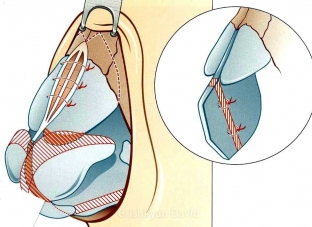Nose correction is one of the most frequently performed plastic surgeries and is considered by patients to be a fairly simple intervention. However, rhinoplasty requires high skill and great experience from the surgeon, since the shape of the nose largely determines not only the attractiveness of the patient's face, but also free nasal breathing. And rhinoplasty of the tip of the nose is no different in complexity from other corrective interventions, because many anatomical features of the nose in each individual patient must be taken into account.
Nose correction and peculiarities of working with its tip
Nose correction requires considerable experience and good knowledge from the surgeon. Before the rhinoplasty operation, the shape of the nose is necessarily discussed in all details with the patient, however, the final decision on the scope of the intervention always remains with the doctor, since incorrect or excessive excision of the cartilaginous structures of the nose can lead to the destruction of its support. In addition, tip rhinoplasty should be performed taking into account the anatomical features of the entire external nose and its structures. At the same time, the following important factors are taken into account individually for each patient:
- skin thickness;
- contour of the bridge of the nose;
- strength of cartilage tissue;
- nasolabial angle, nose parameters.
Depending on the individual characteristics of the nose, the method of rhinoplasty of the tip of the nose is selected.
Rhinoplasty of the tip of the nose: features of the procedure
Important elements of the tip of the nose – these are the septum, pterygoid cartilages, cartilaginous tissue. Nose correction, specifically – its tip is required for some congenital anomalies, damage due to trauma, tumors, diseases, as well as for aesthetic improvement of the shape of the nose (when the tip is excessively fleshy, wide, lowered, upturned, narrowed).

Rhinoplasty of the tip of the nose can be performed using an open or closed technique. The essence of the operation is that the surgeon makes an incision of the required shape, separates the soft tissues from the bone structures and forms the desired shape of the tip of the nose.
If a closed method of nose correction is used, the incision passes inside the mucous membrane, if the open – an incision is made in the area of the nasal bridge. Next, the pterygoid cartilages are isolated and special sutures are applied, which are designed to give the tip of the nose the desired shape. If it is necessary to strengthen or elevate the tip of the nose, a supporting cartilage is used, with a bifurcated tip from birth, the pterygoid cartilages are partially excised and their tips are sutured or cartilage is introduced into the place of retraction.
The closed method is less traumatic and has a shorter recovery time, but it carries the risk of uncontrolled vascular damage and hematoma formation. With open rhinoplasty of the tip of the nose, the risk of errors during the operation is minimized, but the rehabilitation period is lengthened. The patient sees the results of nose correction immediately, but the final result can be assessed no earlier than three months later. The patient should be instructed in detail about the importance of carefully following the doctor's recommendations for caring for the nasal cavity after surgery and during the rehabilitation period, which will help to avoid complications.









Add a comment